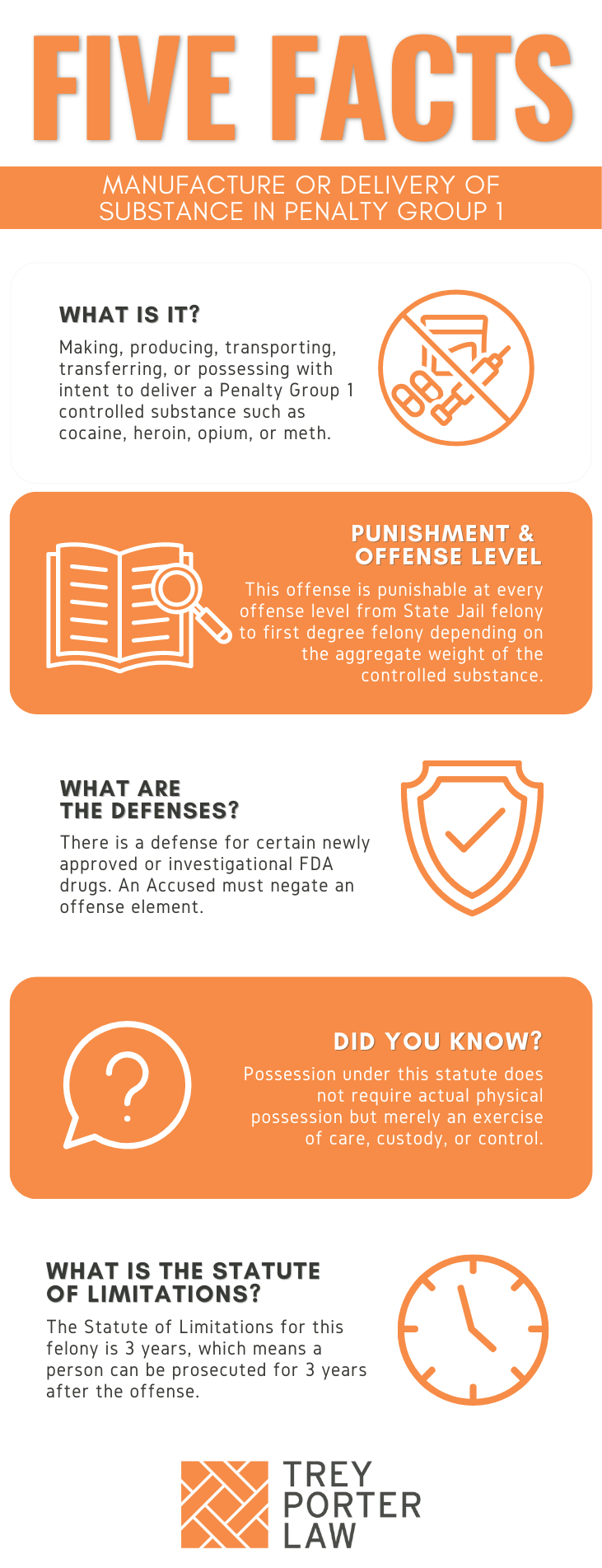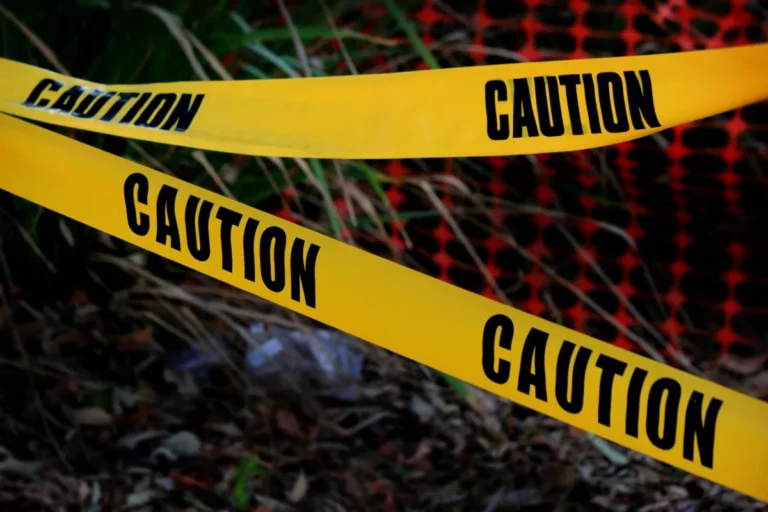WHAT IS MANUFACTURE OR DELIVERY OF SUBSTANCE IN PENALTY GROUP 1 IN TEXAS?
The Texas law against manufacture or delivery of substance in Penalty Group 1 prohibits making, producing, transporting, transferring, or otherwise possessing with the intent to deliver a controlled substance listed in Penalty Group 1.
- What is a controlled substance? Texas Health and Safety Code Section 481.002 defines a “controlled substance” as a substance, including a drug, listed in Schedules I through V or Penalty Group 1, 1-A, 1-B, 2, 2-A, 3, or 4. The term includes the aggregate weight of any mixture, solution, or other substance containing a controlled substance, but does not include “hemp” as defined by Texas Agriculture Code Section 121.001, or the tetrahydrocannabinols in hemp.
- What is the difference between Schedules I, II, III, IV, and V and the penalty groups of controlled substances? Controlled substances are divided into five “schedules” based on potential for abuse or addiction, which dictate the rules medical professionals must follow in prescribing medications listed in each schedule. Schedule I, for example, are the most addictive substances, and may generally not be prescribed. Substances in Schedule I are also typically in Penalty Group 1, and are considered illegal under most circumstances.
Controlled substances are divided into “penalty groups” for determining criminal classification and penalties.
- What controlled substances are in Penalty Group 1 in Texas? Texas Health and Safety Code Section 481.102 lists the following controlled substances in Penalty Group 1:
-
- the following opiates, including their isomers, esters, ethers, salts, and salts of isomers, esters, and ethers, unless specifically excepted, if the existence of these isomers, esters, ethers, and salts is possible within the specific chemical designation:
- Alfentanil;
- Allylprodine;
- Alphacetylmethadol;
- Benzethidine;
- Betaprodine;
- Clonitazene;
- Diampromide;
- Diethylthiambutene;
- Difenoxin not listed in Penalty Group 3 or 4;
- Dimenoxadol;
- Dimethylthiambutene;
- Dioxaphetyl butyrate;
- Dipipanone;
- Ethylmethylthiambutene;
- Etonitazene;
- Etoxeridine;
- Furethidine;
- Hydroxypethidine;
- Ketobemidone;
- Levophenacylmorphan;
- Meprodine;
- Methadol;
- Moramide;
- Morpheridine;
- Noracymethadol;
- Norlevorphanol;
- Normethadone;
- Norpipanone;
- Phenadoxone;
- Phenampromide;
- Phenomorphan;
- Phenoperidine;
- Piritramide;
- Proheptazine;
- Properidine;
- Propiram;
- Sufentanil;
- Tilidine; and
- Trimeperidine;
- the following opium derivatives, their salts, isomers, and salts of isomers, unless specifically excepted, if the existence of these salts, isomers, and salts of isomers is possible within the specific chemical designation:
- Acetorphine;
- Acetyldihydrocodeine;
- Benzylmorphine;
- Codeine methylbromide;
- Codeine-N-Oxide;
- Cyprenorphine;
- Desomorphine;
- Dihydromorphine;
- Drotebanol;
- Etorphine, except hydrochloride salt;
- Heroin;
- Hydromorphinol;
- Methyldesorphine;
- Methyldihydromorphine;
- Monoacetylmorphine;
- Morphine methylbromide;
- Morphine methylsulfonate;
- Morphine-N-Oxide;
- Myrophine;
- Nicocodeine;
- Nicomorphine;
- Normorphine;
- Pholcodine; and
- Thebacon;
- Opium and opiate not listed in Penalty Group 3 or 4, and a salt, compound, derivative, or preparation of opium or opiate, other than thebaine derived butorphanol, nalmefene and its salts, naloxone and its salts, and naltrexone and its salts, but including:
- Codeine not listed in Penalty Group 3 or 4;
- Dihydroetorphine;
- Ethylmorphine not listed in Penalty Group 3 or 4;
- Granulated opium;
- Hydrocodone not listed in Penalty Group 3;
- Hydromorphone;
- Metopon;
- Morphine not listed in Penalty Group 3;
- Opium extracts;
- Opium fluid extracts;
- Oripavine;
- Oxycodone;
- Oxymorphone;
- Powdered opium;
- Raw opium;
- Thebaine; and
- Tincture of opium;
- a salt, compound, isomer, derivative, or preparation of a substance that is chemically equivalent or identical to a substance described above, other than the isoquinoline alkaloids of opium;
- Opium poppy and poppy straw;
- Cocaine, including:
- its salts, its optical, position, and geometric isomers, and the salts of those isomers;
- coca leaves and a salt, compound, derivative, or preparation of coca leaves; and
- a salt, compound, derivative, or preparation of a salt, compound, or derivative that is chemically equivalent or identical to cocaine, other than decocainized coca leaves or extractions of coca leaves that do not contain cocaine or ecgonine; and
- concentrate of poppy straw, meaning the crude extract of poppy straw in liquid, solid, or powder form that contains the phenanthrine alkaloids of the opium poppy;
- the following opiates, including their isomers, esters, ethers, salts, and salts of isomers, if the existence of these isomers, esters, ethers, and salts is possible within the specific chemical designation:
- Acetyl-alpha-methylfentanyl (N-[1-(1-methyl-2- phenethyl)-4-piperidinyl]-N-phenylacetamide);
- Alpha-methylthiofentanyl (N-[1-methyl-2-(2- thienyl)ethyl-4-piperidinyl]-N-phenylpropanamide);
- Alphaprodine;
- Anileridine;
- Beta-hydroxyfentanyl (N-[1-(2-hydroxy-2- phenethyl)-4-piperidinyl] -N-phenylpropanamide);
- Beta-hydroxy-3-methylfentanyl;
- Bezitramide;
- Carfentanil;
- Dihydrocodeine not listed in Penalty Group 3 or 4;
- Diphenoxylate not listed in Penalty Group 3 or 4;
- Isomethadone;
- Levomethorphan;
- Levorphanol;
- Metazocine;
- Methadone;
- Methadone-Intermediate, 4-cyano-2-dimethylamino- 4, 4-diphenyl butane;
- 3-methylfentanyl(N-[3-methyl-1-(2-phenylethyl)- 4-piperidyl]-N-phenylpropanamide);
- 3-methylthiofentanyl(N-[3-methyl-1-(2-thienyl) ethyl-4-piperidinyl]-N-phenylpropanamide);
- Moramide-Intermediate, 2-methyl-3-morpholino-1, 1-diphenyl-propane-carboxylic acid;
- Para-fluorofentanyl(N-(4-fluorophenyl)-N-1-(2- phenylethyl)-4-piperidinylpropanamide);
- PEPAP (1-(2-phenethyl)-4-phenyl-4- acetoxypiperidine);
- Pethidine (Meperidine);
- Pethidine-Intermediate-A, 4-cyano-1-methyl-4- phenylpiperidine;
- Pethidine-Intermediate-B, ethyl-4- phenylpiperidine-4 carboxylate;
- Pethidine-Intermediate-C, 1-methyl-4- phenylpiperidine-4-carboxylic acid;
- Phenazocine;
- Piminodine;
- Racemethorphan;
- Racemorphan;
- Remifentanil; and
- Thiofentanyl(N-phenyl-N-[1-(2-thienyl)ethyl-4- piperidinyl]-propanamide);
- Flunitrazepam (trade or other name: Rohypnol);
- Methamphetamine, including its salts, optical isomers, and salts of optical isomers;
- Phenylacetone and methylamine, if possessed together with intent to manufacture methamphetamine;
- Phencyclidine, including its salts;
- Gamma hydroxybutyric acid (some trade or other names: gamma hydroxybutyrate, GHB), including its salts;
- Ketamine;
- Phenazepam;
- U-47700;
- AH-7921;
- ADB-FUBINACA;
- AMB-FUBINACA; and
- MDMB-CHMICA.
- the following opiates, including their isomers, esters, ethers, salts, and salts of isomers, esters, and ethers, unless specifically excepted, if the existence of these isomers, esters, ethers, and salts is possible within the specific chemical designation:
WHAT IS THE MANUFACTURE OR DELIVERY OF SUBSTANCE IN PENALTY GROUP 1 LAW IN TEXAS?
Tex. Health & Safety Code § 481.112. OFFENSE: MANUFACTURE OR DELIVERY OF SUBSTANCE IN PENALTY GROUP 1.
(a) Except as authorized by this chapter, a person commits an offense if the person knowingly manufactures, delivers, or possesses with intent to deliver a controlled substance listed in Penalty Group 1.
(b) An offense under Subsection (a) is a state jail felony if the amount of the controlled substance to which the offense applies is, by aggregate weight, including adulterants or dilutants, less than one gram.
(c) An offense under Subsection (a) is a felony of the second degree if the amount of the controlled substance to which the offense applies is, by aggregate weight, including adulterants or dilutants, one gram or more but less than four grams.
(d) An offense under Subsection (a) is a felony of the first degree if the amount of the controlled substance to which the offense applies is, by aggregate weight, including adulterants or dilutants, four grams or more but less than 200 grams.
(e) An offense under Subsection (a) is punishable by imprisonment in the Texas Department of Criminal Justice for life or for a term of not more than 99 years or less than 10 years, and a fine not to exceed $100,000, if the amount of the controlled substance to which the offense applies is, by aggregate weight, including adulterants or dilutants, 200 grams or more but less than 400 grams.
(f) An offense under Subsection (a) is punishable by imprisonment in the Texas Department of Criminal Justice for life or for a term of not more than 99 years or less than 15 years, and a fine not to exceed $250,000, if the amount of the controlled substance to which the offense applies is, by aggregate weight, including adulterants or dilutants, 400 grams or more.
Tex. Health & Safety Code § 481.1122. MANUFACTURE OF SUBSTANCE IN PENALTY GROUP 1: PRESENCE OF CHILD.
If it is shown at the punishment phase of a trial for the manufacture of a controlled substance listed in Penalty Group 1 that when the offense was committed a child younger than 18 years of age was present on the premises where the offense was committed:
(1) the punishments specified by Sections 481.112(b) and (c) are increased by one degree;
(2) the minimum term of imprisonment specified by Section 481.112(e) is increased to 15 years and the maximum fine specified by that section is increased to $150,000; and
(3) the minimum term of imprisonment specified by Section 481.112(f) is increased to 20 years and the maximum fine specified by that section is increased to $300,000.
WHAT IS THE PENALTY CLASS FOR MANUFACTURE OR DELIVERY OF SUBSTANCE IN PENALTY GROUP 1 IN TEXAS?
The penalty classification for manufacturing or delivering a controlled substance in Penalty Group 1 depends on the aggregate weight of the controlled substance manufactured, delivered, or in the person’s possession.
- State jail felony, punishable by 180 days to two years in a state jail facility, if:
- the aggregate weight was less than one gram;
- Second degree felony, punishable by two to 20 years in prison, if:
- the aggregate weight was one gram or more but less than four grams;
- First degree felony, punishable by five to 99 years or life in prison, if:
- the aggregate weight is four grams or more but less than 200 grams;
- First degree felony, punishable by ten to 99 years or life in prison, if:
- the aggregate weight is 200 grams or more but less than 400 grams;
- First degree felony, punishable by 15 to 99 years or life in prison, if:
- the aggregate weight is 400 grams or more.
Texas Health and Safety Code Section 481.1122 increases the penalty classification to the next highest category if the offense was committed in the presence of a child under 18 years of age. If the minimum prison sentence is ten years, it is increased to 15 years if committed in the presence of a child. If the minimum sentence is 15 years, it is increased to 20 years.
WHAT IS THE PUNISHMENT RANGE FOR MANUFACTURE OR DELIVERY OF SUBSTANCE IN PENALTY GROUP 1 IN TEXAS?
The punishment range for manufacturing or delivering a controlled substance in Penalty Group 1 corresponds to the penalty classification, which depends on the aggregate weight of the controlled substance.
- 400 grams or more (first degree felony):
- 15 to 99 years or life in prison, maximum $250,000 fine; or
- 20 to 99 years or life in prison, maximum $300,000 fine if the offense was committed in the presence of a child under 18 years old;
- 200 grams or more but less than 400 grams (first degree felony):
- ten to 99 years or life in prison, maximum $100,000 fine; or
- 15 to 99 years or life in prison, maximum $150,000 fine if the offense was committed in the presence of a child under 18 years old;
- Four grams or more but less than 200 grams (first degree felony):
- five to 99 years or life in prison, maximum $10,000 fine;
- One gram or more but less than four grams (second degree felony):
- two to 20 years in prison, maximum $10,000 fine;
- Less than one gram (state jail felony):
- 180 days to two years in a state jail facility, maximum $10,000 fine.
WHAT ARE THE PENALTIES FOR MANUFACTURE OR DELIVERY OF SUBSTANCE IN PENALTY GROUP 1 IN TEXAS?
A person charged with manufacturing or delivering less than a gram of a substance in Penalty Group 1 is eligible for probation after a conviction, or deferred adjudication without a conviction, for a period between two to five years, with the possibility of extending supervision for up to ten years.
A person charged with manufacturing or delivering between one gram and 200 grams of a substance in Penalty Group 1 may be eligible for probation after a conviction, or deferred adjudication without a conviction, for a period not to exceed ten years. A person may only receive probation from a jury after a guilty finding if the person has no prior felony convictions, and the jury assessed a prison sentence of ten years or less.
WHAT ARE THE DEFENSES TO MANUFACTURE OR DELIVERY OF SUBSTANCE IN PENALTY GROUP 1 IN TEXAS?
The exemptions in Texas Health and Safety Code Section 481.111 do not apply to this statute. Texas Health and Safety Code Section 481.123 provides a defense to a person charged with manufacturing, delivering, or possessing a controlled substance if the substance was approved as a new drug by the FDA, or was exempt by the FDA for investigational use.
A person accused of manufacturing or delivering a substance in Penalty Group 1 may attempt to negate at least one of the elements the State must prove at trial.
- What is proof of intent to deal drugs in Texas? To convict a person of the higher offense of possession with intent to deliver a controlled substance, the State must show the accused possessed drugs for a purpose other than personal use. This may be shown by circumstantial evidence, the high volume of drugs, or any admissible statements the accused made during the investigation.For example, in Vega v. State, the defendant was sitting in the driver’s seat of a car with his wife when police approached. They saw marijuana in plain view, searched the car, and found a backpack on the floor when his feet were. Inside the backpack, police found ten baggies of methamphetamine. The backpack also had the defendant’s wallet and other possessions. He was convicted of possession with intent to deliver a controlled substance in PG1 (methamphetamine), and the appellate court affirmed.
- Is a lab test required for drug cases in Texas? Generally, yes. A person should not be convicted of possessing, manufacturing, or delivering a controlled substance in a specifically alleged penalty group without a lab report verifying the drug was the controlled substance alleged.In Ex parte Saucedo, the defendant was indicted for possession of methamphetamine, a controlled substance in Penalty Group 1. He pled before the lab results were sent to the prosecution, and was sentenced. The lab report revealed the defendant was actually in possession of methylethcathinone, a substance in Penalty Group 2. The Court of Criminal Appeals granted habeas relief, and cautioned all trial attorneys and defendants against pleading without all the evidence.
- What is drug possession in Texas? Texas Health and Safety Code Section 481.002 defines “possession” as actual care, custody, control, or management. Possession does not require proof a person is physically holding the controlled substance.In Rodriguez v. State, No. 04-21-00503-CR, the defendant’s girlfriend let her friend drive the defendant to the store. Police stopped the car while the defendant was in the passenger seat, and found 0.18 grams of methamphetamine in a chewing tobacco tin in the glove box. The officer noticed tobacco around the defendant’s mouth, so he was charged with and convicted of possession of less than a gram of a controlled substance in Penalty Group 1.The appellate court affirmed. The drugs were conveniently accessible to the defendant on his side of the car, they were in a tobacco tin, and the defendant chewed tobacco.
- What is a search incident to arrest in Texas? The Fourth Amendment to the U.S. Constitution permits police officers to conduct warrantless searches incident to lawful arrests. The justification for permitting such a warrantless search is: (1) the need for officers to seize weapons or other things which might be used to assault an officer or effect an escape; and (2) the need to prevent the loss or destruction of evidence. See State v. Granville, 423 S.W.3d 399, 410 (Tex. Crim. App. 2014).In State v. Sanchez, an officer approached the defendant’s jeep, which was parked in a grassy area next to a bar with the driver’s door open, the engine turned off, and the defendant was asleep in the driver’s seat. The officer woke the defendant up to check on him, and learned he had traffic warrants. Incident to arrest, the officer searched the defendant’s pockets, and he had cocaine. He was then arrested for possession of a controlled substance in PG 1, his car was searched incident to that arrest, and more cocaine was found. The appellate court upheld the car search as a valid search incident to his arrest for possession.In Botello v. State, police responded to an assault-in-progress. The officer spoke to the victim outside the home, who said the defendant was her estranged husband, had assaulted her, and was still inside. The defendant refused to come out, but the victim consented to a search of the home, so police forcefully went inside. Officers immediately arrested the defendant for assault, searched his pockets, and found over 24 grams of heroin. He was convicted of possession of a controlled substance in PG 1, and the appellate court affirmed.
- What Penalty Group is codeine in Texas? Penalty Group 1 includes codeine “not listed in Penalty Group 3 or 4.” This means if the State alleges the accused possessed codeine, the State must prove the person possessed a substance containing more than 1.8 grams of codeine per 100 milliliters, or more than 300 milligrams of dihydrocodeine per 100 milliliters.In Miles v. State, the defendant was convicted of possession of over 200 grams of codeine in PG1 with intent to deliver. The lab results showed the codeine he possessed had a concentration of 158 milligrams of codeine per 100 milliliters, which is a substance in PG 3. The Court of Criminal Appeals reversed the defendant’s conviction, and acquitted him because of the failure to allege and prove the codeine was of a concentration listed in PG 1.
WHAT IS THE STATUTE OF LIMITATIONS FOR MANUFACTURE OR DELIVERY OF SUBSTANCE IN PENALTY GROUP 1 IN TEXAS?
The limitation period for manufacture or delivery of a substance in Penalty Group 1 is three years.
MANUFACTURE OR DELIVERY OF SUBSTANCE IN PENALTY GROUP 1 IN TEXAS
Texas punishes manufacturing, cooking, growing, transporting, delivering, or otherwise possessing with the intent to deliver a controlled substance in Penalty Group 1 in any amount as a felony.
TEXAS MANUFACTURE OR DELIVERY OF SUBSTANCE IN PENALTY GROUP 1 COURT CASES
The case law regarding manufacture or delivery of substance in Penalty Group 1 in Texas gives examples of evidence supporting a conviction.
- In Espino-Cruz v. State, the defendant was a passenger in a car carrying over 7 pounds of heroin in the trunk. He was convicted of possession with intent to deliver over 400 grams of a controlled substance as a party (his co-defendant was the driver), but argued on appeal he never exercised care, custody, or control of the heroin, nor did he know he was in possession of heroin.
The appellate court affirmed. Police testified that when a drug-buy for four kilos is arranged, typically two sellers are present. The confidential informant who arranged the transaction also referred to the dealers in plural, Finally, the significant quantity is inconsistent with personal use, and the method of packaging shows the intent to deliver.













